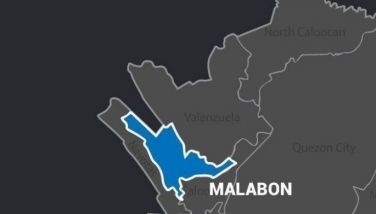US scientists arriving for final rehab study
June 7, 2003 | 12:00am
An American team is set to begin on Monday a study for the final rehabilitation of areas affected by the 1996 Marcopper mine tailings dam spill in Marinduque, the Department of Environment and Natural Resources (DENR) announced yesterday.
Environment Secretary Elisea Gozun said the team will spend six days for the mine safety and engineering assessment of the mine site. This, she added, marks the formal conduct for a 18-month Marinduque Environmental and Health Study (MEHS) by the US scientists.
"The MEHS is a crucial step for the rehabilitation effort, and the DENR, through the Mines and Geosciences Bureau, is giving utmost support to the US team to ensure the success of the study," Gozun said.
The US team will consist of specialists from three different US organizations — the US Geological Survey (USGS), led by Dr. Jack Medlin; the Armed Forces Institute of Pathology Scientists, led by Dr. Jose Centeno; and the University of Arizona, led by Dr. Hugh Miller and James Madson.
The study, which will cost P20 million, will be funded by President Arroyo’s Social Fund. Half of the fund has been turned over to the Marinduque provincial government, the DENR said.
According to Gozun, the MEHS would include a comprehensive mine environmental and health assessment, evaluation of the final remediation options, and preparation of a monitoring program for the Boac and Mogpog rivers, the Marcopper mining site and the Calancan Bay.
MGB director Horacio Ramos said his bureau will send its best mining and environmental experts to the area to assist the US team.
Through the close collaboration of the US and MGB panels, Ramos expects the bureau to gain knowledge and technology that may be used in other mining areas in the country.
The disaster at the Marcopper mining site took place in March 1996 when the plug of the drainage tunnel of the company’s old Tapian open pit, then being used for tailings disposal, failed. This resulted in the accidental release of tailings into the Boac River.
The spill deposited approximately 1.6 million cubic meters of mine tailings into the 26-kilometer river, causing serious damage to the environment and communities dependent on the river.
In September 2002, Placer Dome Inc., Marcopper’s foreign partner, committed $12 million for the rehabilitation of the Boac River and $1 million as compensation for those affected by the tailings spill.
However, local leaders requested that the USGS first conduct a thorough rehabilitation study before any actual remediation measures are carried out.
The provincial government endorsed the hiring of an independent technical review consultant for the MEHS on March 3, 2001.
In May 2002, the DENR said, the USGS conducted a preliminary examination of the environmental problems caused by the spill.
Gozun said additional visits were planned last year but were delayed due to negative travel advisories brought about by threats of terrorism.
Environment Secretary Elisea Gozun said the team will spend six days for the mine safety and engineering assessment of the mine site. This, she added, marks the formal conduct for a 18-month Marinduque Environmental and Health Study (MEHS) by the US scientists.
"The MEHS is a crucial step for the rehabilitation effort, and the DENR, through the Mines and Geosciences Bureau, is giving utmost support to the US team to ensure the success of the study," Gozun said.
The US team will consist of specialists from three different US organizations — the US Geological Survey (USGS), led by Dr. Jack Medlin; the Armed Forces Institute of Pathology Scientists, led by Dr. Jose Centeno; and the University of Arizona, led by Dr. Hugh Miller and James Madson.
The study, which will cost P20 million, will be funded by President Arroyo’s Social Fund. Half of the fund has been turned over to the Marinduque provincial government, the DENR said.
According to Gozun, the MEHS would include a comprehensive mine environmental and health assessment, evaluation of the final remediation options, and preparation of a monitoring program for the Boac and Mogpog rivers, the Marcopper mining site and the Calancan Bay.
MGB director Horacio Ramos said his bureau will send its best mining and environmental experts to the area to assist the US team.
Through the close collaboration of the US and MGB panels, Ramos expects the bureau to gain knowledge and technology that may be used in other mining areas in the country.
The disaster at the Marcopper mining site took place in March 1996 when the plug of the drainage tunnel of the company’s old Tapian open pit, then being used for tailings disposal, failed. This resulted in the accidental release of tailings into the Boac River.
The spill deposited approximately 1.6 million cubic meters of mine tailings into the 26-kilometer river, causing serious damage to the environment and communities dependent on the river.
In September 2002, Placer Dome Inc., Marcopper’s foreign partner, committed $12 million for the rehabilitation of the Boac River and $1 million as compensation for those affected by the tailings spill.
However, local leaders requested that the USGS first conduct a thorough rehabilitation study before any actual remediation measures are carried out.
The provincial government endorsed the hiring of an independent technical review consultant for the MEHS on March 3, 2001.
In May 2002, the DENR said, the USGS conducted a preliminary examination of the environmental problems caused by the spill.
Gozun said additional visits were planned last year but were delayed due to negative travel advisories brought about by threats of terrorism.
BrandSpace Articles
<
>
- Latest
- Trending
Trending
Latest
Trending
Latest
Recommended
January 21, 2025 - 12:00am




























